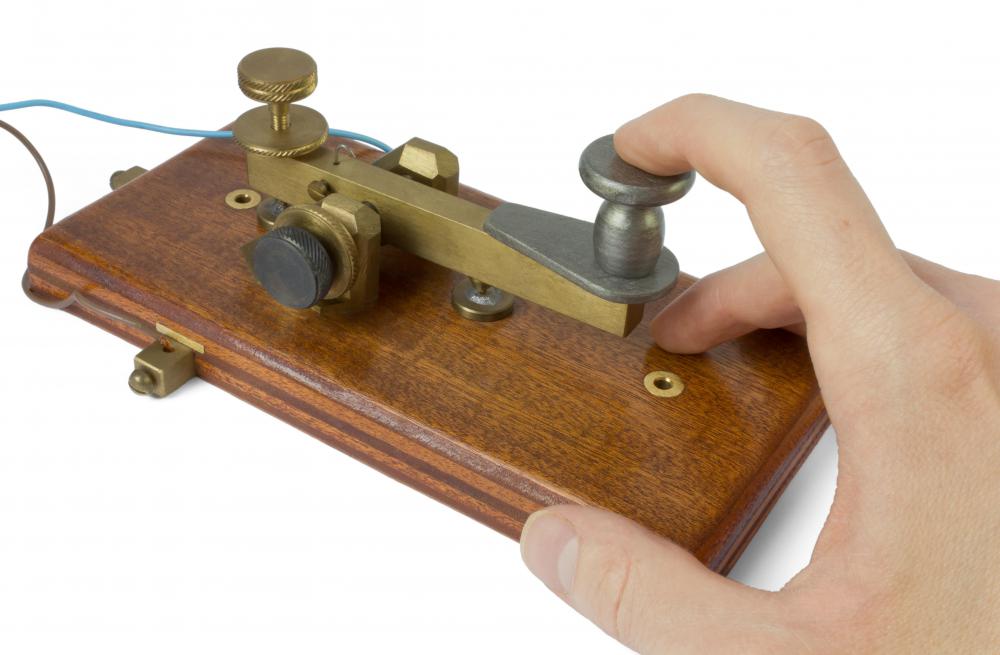At WiseGEEK, we're committed to delivering accurate, trustworthy information. Our expert-authored content is rigorously fact-checked and sourced from credible authorities. Discover how we uphold the highest standards in providing you with reliable knowledge.
What Was the Golden Spike?
The Golden Spike was a commemorative railway spike manufactured to celebrate the completion of construction on the Transcontinental Railroad, the first railroad to stretch all the way across the United States. In a heavily publicized ceremony in 1869, the Golden Spike was ceremonially driven into the last railroad tie, officially joining the two halves of the railroad, and a telegraph message announced “DONE” to the world. Promptly after the ceremony, the spike was removed, and replaced with a regular spike.
The Transcontinental Railroad was an ambitious cooperative project involving the Union Pacific Railroad and the Central Pacific Railroad. The two worked from opposite ends of the country, laying tracks which eventually met in Utah Territory. Realizing the magnitude of the event, the heads of the railroads decided to hold a formal ceremony to celebrate the completion of the track, and contractor David Hewes suggested manufacturing a ceremonial golden spike, silver spike maul, and a special railroad tie made from California laurel wood for the event.

For the ceremony, two locomotives were drawn up on either side of the track to face each other, and Leland Stanford, head of the Central Pacific Railroad, drove the spike into the specially prepared tie. Historical accounts of the event vary; some people said that Stanford was unable to push the spike all the way in, and as a result an ordinary rail worker took over for the last few blows.

Once the Golden Spike had been admired in situ, the spike and special tie were removed, and replaced with an ordinary tie and a regular iron spike in a “Last Spike” ceremony. The spike went on display before being returned to David Hewes, who ultimately donated it to Stanford University, where it remains on display today. In addition to the original Golden Spike, at least two replicas were made, along with a silver spike, and pieces of the spike were also used to make watch fobs for prominent railway officials.

The Golden Spike is commemorated on the Utah state quarter, and numerous other railroads followed the example of the Transcontinental Railroad in the decades to come, manufacturing their own commemorative engraved spikes. These items reside primarily in private collections today, although some history museums with an interest in transportation have managed to obtain golden and silver spikes linked with various railway ceremonies.
AS FEATURED ON:
AS FEATURED ON:













Discussion Comments
@bear78-- Are you sure that those pictures are the real pictures?
They may also be pictures of the re-enactment Golden Spike ceremony which took place in 1952. If you visit the National Historic site today, you can take part in a re-enactment yourself and place "the Golden spike." Of course, you won't be placing it on the actual railroad, just a replica. But it's still an exciting activity for those interested in the history of the Transcontinental Railroad.
@fify-- There are actually eye witness accounts of the ceremony in books and articles. You will get a good idea of what the ceremony was like from these. There are even colored pictures of the ceremony now, the black and white pictures have been digitally remastered and colored. So it does feel like being there.
@Scrbblchick-- I agree with you. The completion of the Transcontinental Railroad was a huge accomplishment. And it made such a significant difference in American economy and the lives of Americans. Transport of goods and people became so much easier afterward.
I sort of wish we could still travel across the country in a train. Trains are faster, less costly and more exciting in my opinion. And it would have been great to witness the Golden Spike ceremony. My grandfather is quite old now, but not old enough to have witnessed the completion of the railroad. Some of us here may have grandparents that are old enough to remember it though.
The Promontory site is one of the places I intend to visit when I go out West again. I like to see historic sites whenever I can if I visit a new place, and this is certainly one to see.
I've never been to Utah so I'd like to see some of the state and visit some other places like the Great Salt Lake. I've flown over it and it's incredible from the air, but I've never actually seen it.
If I ever make it to the Stanford campus, I intend to see the Golden Spike, too. The larger historical significance of that artifact is just staggering.
I figured the Golden Spike would end up at the Smithsonian in the Museum of Transportation History. I'm glad it's at Stanford, though, where it will also be preserved properly.
I've seen some of the photographs of the event, with the locomotives facing each other. This is one of those historical events I would love to have seen. It is quite incredible that the Central Pacific and the Union Pacific were able to cross the country. When I think about what it must have been like to cross some of the territory they had to cover, like the Rockies, I marvel all over again at it.
Post your comments